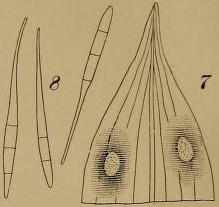Cercosporella
Cercosporella is a genus of fungi belonging to the family Mycosphaerellaceae. This genus includes several species known for causing leaf spot diseases on a variety of plant hosts. The members of this genus are characterized by their ability to produce small, dark-colored spores that can cause significant damage to the foliage of infected plants, leading to reduced photosynthesis, vigor, and yield.
Characteristics[edit | edit source]
Cercosporella fungi are typically identified by their microscopic features, including the presence of conidiophores and conidia. Conidiophores are specialized fungal structures from which spores are produced and released. The conidia of Cercosporella species are usually slender, multicellular, and dark in color, which helps in their identification and differentiation from other fungal pathogens.
These fungi are known to be pathogens, causing diseases primarily in the form of leaf spots. The spots can vary in color from tan to brown or black, often surrounded by a chlorotic (yellowed) area. The disease cycle of Cercosporella involves the production of spores that are dispersed by wind or rain splash, infecting new leaves and spreading the disease.
Host Range and Economic Impact[edit | edit source]
Cercosporella species have a wide host range, affecting various crops, ornamentals, and weed species. Some species are host-specific, causing disease only on a particular group of plants, while others have a broader host range. The economic impact of Cercosporella leaf spot diseases can be significant, especially in agricultural and horticultural systems where high levels of leaf spot can lead to substantial yield losses.
Management[edit | edit source]
Management of Cercosporella leaf spot diseases involves an integrated approach combining cultural, biological, and chemical strategies. Cultural practices such as crop rotation, removal of infected plant debris, and avoiding overhead irrigation can help reduce the inoculum load and disease spread. Biological control using fungal antagonists or bacterial agents has been explored for some Cercosporella diseases but is not widely implemented. Chemical control with fungicides may be necessary in severe cases, especially for high-value crops. However, the development of fungicide resistance is a concern, and thus fungicides should be used judiciously as part of an integrated disease management strategy.
Taxonomy[edit | edit source]
The taxonomy of Cercosporella has been subject to revision, with molecular phylogenetic studies providing new insights into the relationships within the Mycosphaerellaceae family. As a result, some species formerly classified within Cercosporella have been moved to other genera based on DNA sequence data. The accurate identification and classification of Cercosporella species are crucial for effective disease management and understanding the evolutionary relationships among plant pathogenic fungi.
| This article is a stub. You can help WikiMD by registering to expand it. |
Search WikiMD
Ad.Tired of being Overweight? Try W8MD's physician weight loss program.
Semaglutide (Ozempic / Wegovy and Tirzepatide (Mounjaro / Zepbound) available.
Advertise on WikiMD
|
WikiMD's Wellness Encyclopedia |
| Let Food Be Thy Medicine Medicine Thy Food - Hippocrates |
Translate this page: - East Asian
中文,
日本,
한국어,
South Asian
हिन्दी,
தமிழ்,
తెలుగు,
Urdu,
ಕನ್ನಡ,
Southeast Asian
Indonesian,
Vietnamese,
Thai,
မြန်မာဘာသာ,
বাংলা
European
español,
Deutsch,
français,
Greek,
português do Brasil,
polski,
română,
русский,
Nederlands,
norsk,
svenska,
suomi,
Italian
Middle Eastern & African
عربى,
Turkish,
Persian,
Hebrew,
Afrikaans,
isiZulu,
Kiswahili,
Other
Bulgarian,
Hungarian,
Czech,
Swedish,
മലയാളം,
मराठी,
ਪੰਜਾਬੀ,
ગુજરાતી,
Portuguese,
Ukrainian
WikiMD is not a substitute for professional medical advice. See full disclaimer.
Credits:Most images are courtesy of Wikimedia commons, and templates Wikipedia, licensed under CC BY SA or similar.
Contributors: Prab R. Tumpati, MD

